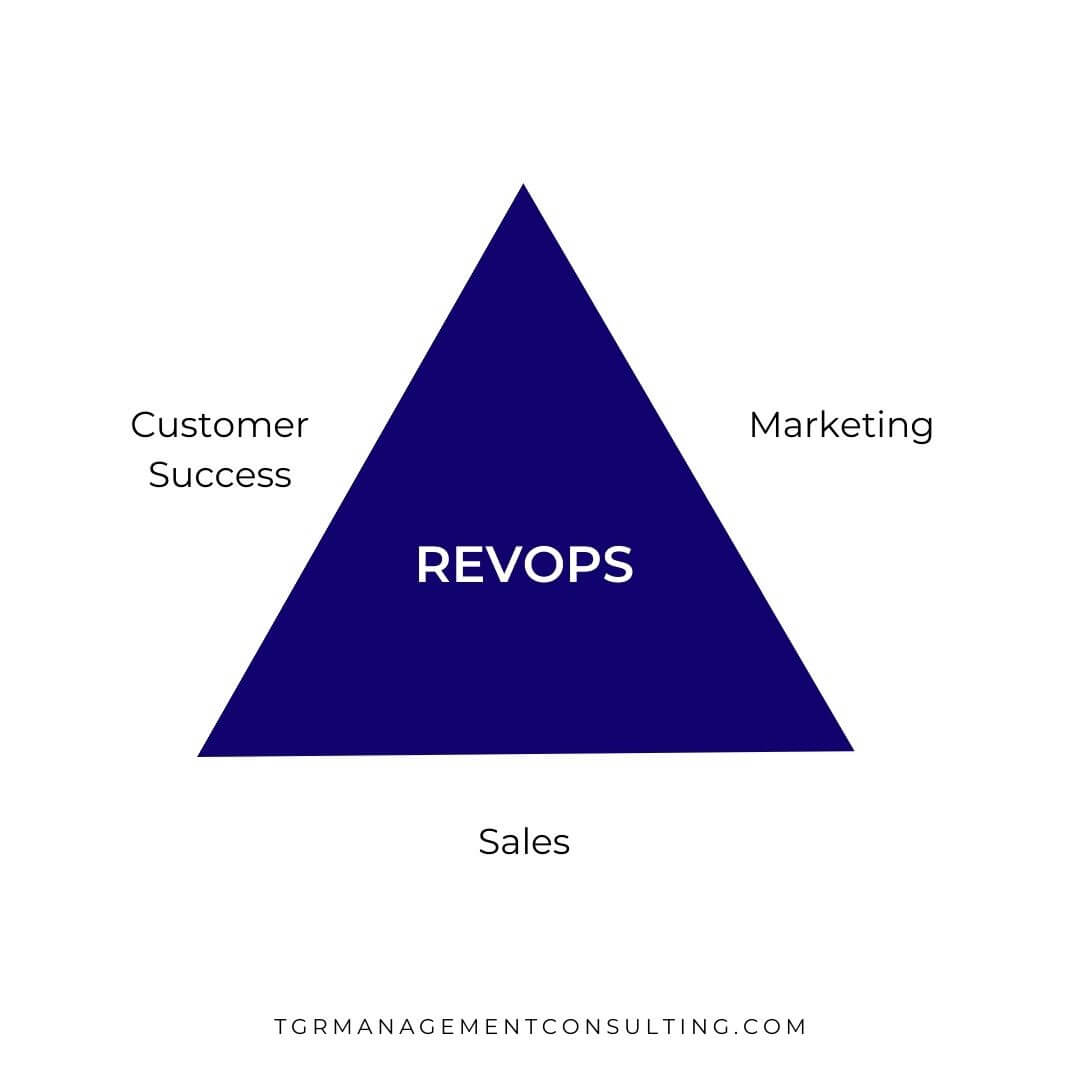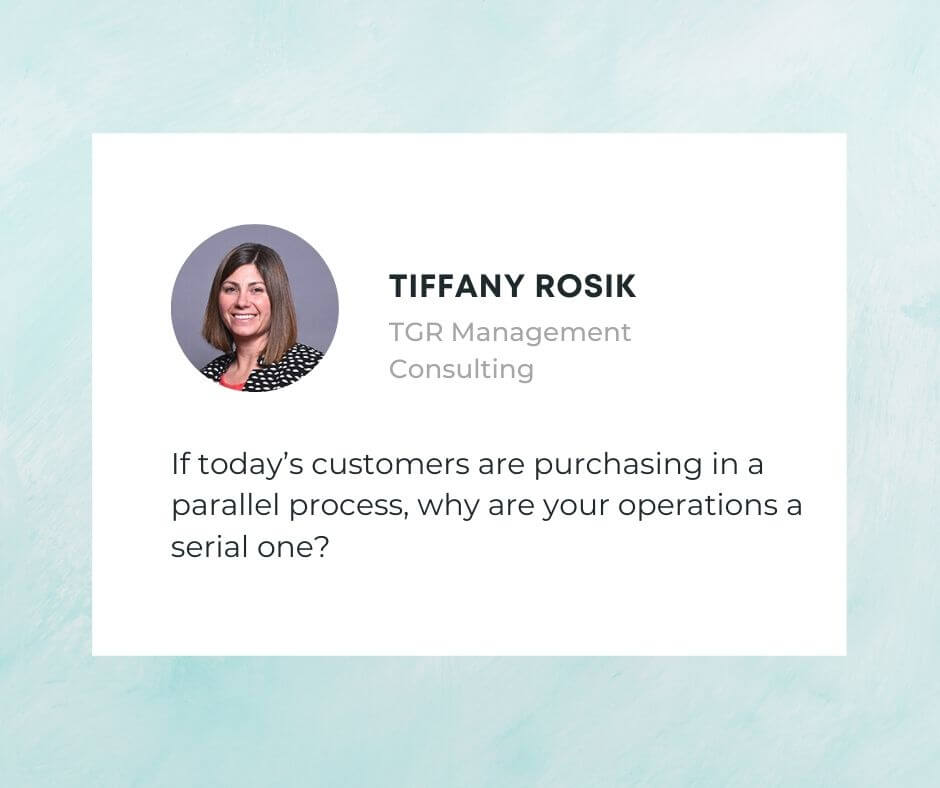Revenue Operations (aka RevOps) is a new buzzword that has been gaining traction amongst businesses in the last few years. Gartner predicts 75% of the highest growing companies in the world will deploy a RevOps framework by 2025.
So, what exactly is revenue operations and how do you get started?
What is Revenue Operations (RevOps)?
RevOps simply is a combination of “revenue” and “operations”. It cannot be pinpointed to a specific process, tool, or new department (although it takes the shape in a combination of these.) RevOps is best described as a framework.
Revenue operations (aka RevOps) is a framework that brings marketing, sales, and customer success teams closer together, to increase alignment, accountability, and efficiency to drive sales and revenue growth.
RevOps consolidates these historically siloed teams and their individual goals into a unified team to have full funnel accountability by looking at the same, big-picture view so they can understand their role and sync up their tactical work to achieve a common goal — increase revenue.

How Is Sales Operations Different Than Revenue Operations?
The core objectives of sales operations are to drive higher, faster, more efficient sales results by providing support where it is needed most in both pre-sale activities (i.e. lead generation) as well as post-sale activities (i.e. sales forecasting).
SalesOps relies on a single department–typically the Sales team– for sales revenue. It is the day-to-day tactical work that is entirely dedicated to “selling” in order to drive growth.
RevOps looks at the strategic alignment of the customer journey and the respective departments to maximize revenue.
Challenges with SalesOps
With siloed departments–including sales–the teams’ priorities and goals are set by their respective leaders. SalesOps may be successful on a short-term basis or demonstrate some short-sided success in increased revenue. However, this is not fully aligned with the customer journey so it won’t yield long-term incremental growth.
In the traditional department approach, each operations team has different priorities, goals, and incentives. Without a single mission, the teams don’t understand how their activities drive revenue.
If we put each department’s role and activity inside the customer journey, it helps illustrate the importance of their role, how it helps produce revenue and potentially eliminates activities that are duplicative or not revenue-producing.
Today’s Customer Journey
Customers don’t buy in a linear fashion–marketing then sales. Buyers use both digital and in-person channels equally to complete the purchasing decisions simultaneously.
As a result, in today’s world of buyer’s purchasing, there is not a handoff from marketing to sales, or digital to in-person.
If today’s customers are purchasing in a parallel process, why are your operations a serial one?

In turn, the sales team has little opportunity to influence the customer’s decisions. The sales team conversations shifted from closing to cultivating the relationship.
The sales operation framework and silo is ill-equipped to adapt to a potential buyer expecting a seamless customer journey.
The Customer Journey with RevOps
During the customer journey, all areas of the experience need to run smoothly.
RevOps coordinates and optimizes every stage of that journey–from advertisements and marketing, the purchase (sales), and the onboard experience (customer success), ensuring the entire process is a smooth process.
RevOps strategically balances the needs of the customer and aligns all departments to work in harmony towards revenue generation.
It is important to keep in mind that the RevOps framework recognizes that revenue isn’t just an outcome but rather a full process involving the strategic convergence of sales, marketing and customer success as part of the customer journey.
Why RevOps?
The sales and marketing funnel is changing.
This focus allows for “customer-centric insights” such as understanding what customers want or need and aligning business processes with those needs maximizing revenue growth.
According to a survey by LeanData, 95% of executives say that customer experience is the key to unlocking revenue growth.
RevOps has emerged as a solution to revenue growth. The framework allows businesses to address the customer’s needs while optimizing areas affecting revenue generation.
How to Get Started with RevOps
To get started, audit your organization and focus on the following three areas:
- Processes and Content Optimization: Review existing processes and content making, noting the complete customer journey.
- Technology Consolidation: Identify the sales (services or products), marketing, and customer success technologies: taking note if there are similar features between them that could feasibly work with one another. Leverage the operations using the software and tools (you most likely already have). Reduce SaaS waste through process optimization and simplify the technology by eliminating redundancies.
- Talent Acquisition and Development: Evaluate and analyze existing processes and revenue-generating roles determining gaps. Create a roadmap with the business operations team with role-specific tasks focusing on how to retain and shape the talent especially in a gig economy.
How Do You Measure The Success of RevOps?
RevOps is successful when it meets the customer’s needs while optimizing every area that affects revenue generation. So, how do you measure this?
In order to understand the success, measure a few key things:
- The cost of acquiring customers –from advertising campaigns to sales commissions
- The cost of onboarding customers–from an increased support workload and support call volume
- The revenue your customers generate over a lifetime of the product (the average monthly customer spending by the average number of months customers use the product)
- Short-term goals and tactics each individual department is working on
- Long term RevOps Goals for the RevOps Team
- Reduced Churn
- Increased Revenue
Find Out More About RevOps
To find out more about RevOps framework, whether it is right for your organization, and how to get started, TGR Management Consulting and our partners will be hosting a FREE webinar in November 2021. Provide your email address here to be notified when registration opens.
___________
Need Help getting started?
If you need a strategic partner for implementing RevOps across your organization, let’s talk.
TGR Management Consulting is a proud woman-owned consulting company, focused on helping companies maximize efficiency, elevate productivity, and amplify profitability. Connect or follow Tiffany Rosik, CEO of TGR Management Consulting on LinkedIn.




